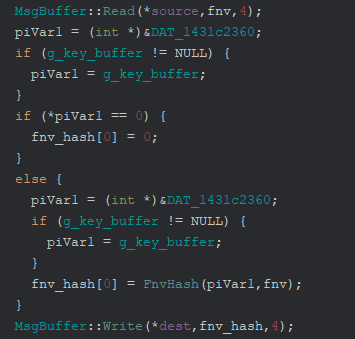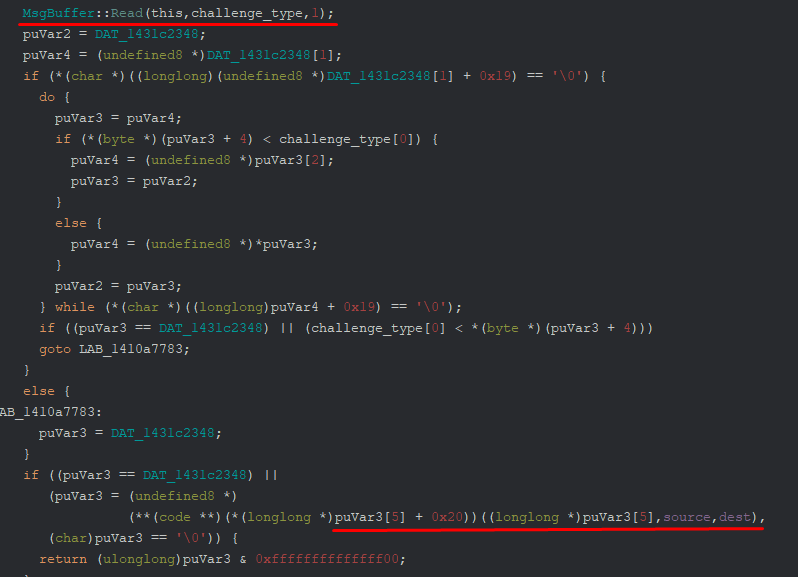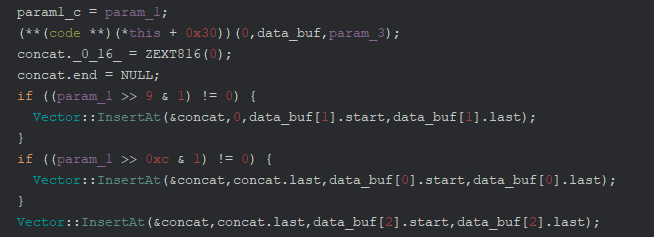Some time around 2020/21, I began to build a server implementation for a certain game after some prior work on GitHub helped kickstart the efforts. Soon enough, more people with aligned interests were gathered and we bounced information on various technical aspects of said game.
Eventually we had most of the obscure details worked out…except for their network transport encryption. And if you know anything about crypto in video games you rightly suspect bad things ahead.
Procrastinating the Task#
Upon discussing it, we realized nobody actually looked into it in full detail. Someone built a tool capable of dumping plaintexts by hooking the game’s crypto functions and grabbing their inputs and outputs, but that was about it.
We observed that the patch server, unlike the game servers, still communicates in plaintext. So we tracked down a difference in Session Offer/Accept packet structures and quickly learned that the server gets to decide whether it wants the client to encrypt the traffic or not.
Being the server author, this puts me in a very comfortable position. With trivial effort I was able to circumvent the encryption and never had to bother with it again.
Tackling the Key Exchange#
Around the same time, an independent group of researchers reached out to me for unrelated reasons. One of them later began to dive into the transport crypto out of personal curiosity and wrote their findings down in their own blog post.
We learned that ciphertexts of the public keys, along with symmetric keys and IVs for decryption are stored as one big blob in the client binary - presumably to limit our ability to search for magic ASN.1 structure bytes.
The author has since built pubkey-extract, which is
capable of extracting the RSA public keys from the binary and even injecting controlled key pairs.
The baseline is:
Server sends Session Offer which selects one of the embedded public keys and confirms their validity through an attached signature
Client sends Session Accept storing randomly generated AES key and nonce, encrypted with the selected public key
Subsequent communication is encrypted and authenticated with AES-GCM using the exchanged key and nonce
From that point we still have plenty of work to do so let’s get our hands dirty.
Message structures#
From Connor’s work, we know the function where all the magic is happening. With more digging, we can identify routines for binary data parsing, which allow recovering the structure of the signed payload in Session Offer fairly quickly:
| Offset | Type | Description |
|---|---|---|
| 0xE | uint32 | Length prefix for the following |
| 0x12 | uint8 | A set of bit flags |
| 0x13 | uint8 | The selected key slot |
| 0x14 | uint8 | The key xor mask for deobfuscation |
| 0x15 | uint8 | Challenge length in bytes |
| 0x16 | uint8[] | Serialized challenge data |
| _ | uint32 | An echo value to send back as-is |
| _ | uint8[256] | RSA signature over this blob |
The same function then proceeds to build a response payload for Session Accept. We can reconstruct it as follows:
| Offset | Type | Description |
|---|---|---|
| 0x10 | uint32 | Length prefix for the following |
| 0x14 | uint8 | A set of bit flags |
| 0x15 | uint8 | Magic value 0x8? Maybe bitflags? |
| 0x16 | uint8[] | Serialized challenge response |
| _ | uint32 | The echo value from Session Offer |
| _ | int32 | The current time as UNIX timestamp |
| _ | uint8[16] | 128-bit AES key for encryption |
| _ | uint8[16] | 128-bit GCM nonce |
NOTE: Only the portion starting from 0x15 is RSA-encrypted.
NOTE(2): Don’t get me started on those bloody 32-bit timestamps.
Challenges, or: Nightmare Fuel#
Ok, you’ve read this and most of it seems self-explanatory. But what’s the deal with these ominous challenges?
Let’s take a look at the handler function to find out. It is given the input buffer of
challenge data (source) and an output buffer for the resulting answer (dest).

We are first reading two u16s (merged into one u32 here, but equivalent results) values
which encode an offset into the static public key buffer and the length of subsequent bytes
to hash with FNV-1a.
NOTE:
pubkey-extract, which was mentioned before, extracts the key buffer in question for that reason as well.

The next part is where the real juice is happening. Most of this is an optimized access pattern into a global map, so only the highlighted parts are relevant.
We’re reading 1 byte (challenge_type) from our input buffer, then searching for a corresponding
entry in some map, and finally delegating to a virtual function call on the object we found.
At the time of writing, we only ever get the same challenge type 0xF1:

We see it reads three more u32 values, does some calculations in another function and writes the
resulting u32 value to the output.
Little did we know what would be awaiting us at that time.

Concatvecs#
This function would greet us with another virtual call which populates 3 byte vectors and then
performs concat operations into one big vector depending on the bits set in the first u32
argument.

But what is the data we’re actually concatenating? A glance at the virtual call didn’t reveal much.
Lots of obscure garbage and little motivation to detangle it. But one thing stood out - the
repeated use of the third u32 argument in a certain function:
def scramble_buffer(data: bytes, key: int) -> bytes:
buf = bytearray()
key_bytes = key.to_bytes(4, "little")
step = (key & (1 << 3)) >> (3 - 0)
| (key & (1 << 5)) >> (5 - 1)
| (key & (1 << 7)) >> (7 - 2)
| (key & (1 << 14)) >> (14 - 3)
| (key & (1 << 18)) >> (18 - 4)
for b in data:
if step != 0 and len(buf) != 0 and len(buf) % step == 0:
buf.append(buf[-1])
buf.append(key_bytes[len(buf) & 3] ^ b)
return buf
Wait a sec. Run this function again chief. What? Almost the original data but not quite? Yeah,
this function is reversible. And although it took us a few nights of debugging to get it right
(we had not only implemented unscramble_buffer incorrectly but also scramble_buffer!), it
came together in the end:
def unscramble_buffer(data: bytes, key: int) -> bytes:
buf = bytearray()
key_bytes = key.to_bytes(4, "little")
step = (key & (1 << 3)) >> (3 - 0)
| (key & (1 << 5)) >> (5 - 1)
| (key & (1 << 7)) >> (7 - 2)
| (key & (1 << 14)) >> (14 - 3)
| (key & (1 << 18)) >> (18 - 4)
i = 0
while i < len(data):
if step != 0 and len(buf) != 0 and i % step == 0:
i += 1
buf.append(key_bytes[i & 3] ^ data[i])
i += 1
return buf
Running unscramble_buffer on the output vectors of the vcall…we just got different data
we still couldn’t make much sense of!
ClientSig#
We did debug the same spot many times after that, always dumping the three populated vectors
and the scramble key and running unscramble_buffer on it - the output stayed consistent.
At this point we were a bit stuck. We would navigate the binary for scramble_buffer occurences
to see if maybe there’s an easier way to approach this than having to reverse all the logic for
filling these vectors. :face_vomiting:
And the most promising thing we eventually stumbled across was the use of this function in a
handler routine for the -CS CLI flag. It uses an embedded public key to validate a
base64-encoded argument to the flag, then runs the obscure logic we’ve seen before, and
finally encrypts it before writing it to a file called ClientSig.bin.
We notice two things: this function uses a 512-bit RSA public key and it implements the check for the argument incorrectly - any 64 base64-encoded bytes will pass.
The first approach was to inject a custom public key for being able to decrypt the output. That worked semi-well - we were able to identify two of the three vectors from earlier in it, but one segment changed completely.
We were eventually able to map them out as “where’s waldo” (mostly the same repeated data with very slight changes every now and then), offsets and code bytes from these offsets; kinda what you would expect from a “ClientSig”.
A researcher eventually figured out that the waldo buffer was module hashes and that the renamed
executable (_Patched suffix in the script) caused this deviation.
However, we didn’t bother with that script anymore because it didn’t take a day for us to factorize the public key instead. So from then on, we used the actual private key to dump the ClientSig:
.\Client.exe -CS fHL4SVK/N2rcUosoHzNwHV7L4am/xFMmhdwh3ETRepJPUwQ501SGKt9UUawD7OG1hDdC0/QfgYqOneI3L32HgA==
.\decrypt_client_sig.py ClientSig.bin
And indeed now the results matched! That being said, the script (with some modifications to not rename the binary) will be viable for dumping the correct ClientSig as well.
SHA256(private key) = D85D95250012B3B030E7D32B3EF54963C97712C870CB6B7B32DB8E089A1B9E2B
Completing the puzzle#
At that point, most of the heavy lifting was done.

We know the “scrambled” segments of ClientSig.bin are concatenated into a vector in varying order, and now we’re running another round of byte XOR on it with no apparent purpose.

And lastly, we can see the final hash which is configured by certain bitfields in the second argument.
The actual byte processing function is selected from an array, including FNV-1a and FNV-1, Jenkins one_at_a_time, and finally PJW hash.
Now that we arrived at the other side of hell at last, we might call it a day here. To wrap it up, here is a reference implementation of everything in its full glory.
Symmetric encryption#
This one actually messed up us for days, to the point where we had to gather for late-night sessions of Reversing Telephone™.

I’ll make the results of these endeavors short and simple because I’d like to discuss the implications rather than the algorithm.
The game uses AES-GCM with a key and nonce exchanged in Session Accept. All the subsequent
traffic will be encrypted. After every n blocks worth of encrypted data, a new random nonce
and an authentication tag for the whole block of data processed so far will be attached.
I have decompiled and documented the client class which handles that for reference as well, if anyone wishes to implement this functionality.
Frame headers travel through the two-argument Process, whereas frame bodies are passed to
the four-argument Process.
The client authenticates 0x100 blocks of outgoing traffic at once, whereas the server
authenticates 0x1000 blocks.
“AES-GCM is secure”#
AES-GCM sucks for plenty of reasons, but it is in fact a very solid choice to reach out for most of the time.
But let’s address the elephant in the room - security is only granted as long as you’re playing by the rules of the construction. And that might not necessarily be something you are closely familiar with when your decision finding process looks like this:

GCM Streaming#
AES-GCM uses AES-CTR for encryption underneath, so it shares the property of CTR that enables decrypting data in a streaming fashion, effectively making it a stream cipher.
By XORing some of the keystream with the corresponding chunk of ciphertext, we can decrypt data without needing the full message at once. However, the first and foremost rule of any AEAD is that any data is atomic waste before the authentication tag was verified. Otherwise, this will inevitably lead to doom.
In fact, many libraries are tailored around this fact and don’t grant access to plaintexts
before the authenticity and integrity of the message was verified. Some candidates like
CryptoPP however behave just like an ordinary CTR cipher
on repeated calls to ProcessData… 🤬
Reordering and Truncating#
This is a general issue to address when chunking AEADs, which has been described in greater detail here.
An attacker can intercept traffic, replace the plaintext nonce after every 0x1000 byte chunk, and
transmit a different chunk along with its valid auth tag and a new nonce instead. Likewise, chunks
can be completely omitted this way.
TLS approaches this by keeping an internal count of messages and including the current count in AAD for each message. The receiving end would then check if the expected counter value is given.
This is optimal for TCP-based protocols where delivery of every packet in order is guaranteed.
Conclusions#
That concludes the journey for today. We reverse-engineered the transport encryption that prevented communication with the server except through the official client. Much love to all the folks who helped make it happen.
At this point I’m not sure of the goal of all this - prevent packet injection? Obfuscate the interface to make analysis harder? Protect against cheaters? Probably a bit of everything yet nothing worked out.
Nonetheless, I personally hope the knowledge and code samples are put to good use. I’d love to see more amazing projects of the likes of custom clients, datamining and analysis tools, further reverse engineering efforts happen!
Reply by EmailAlso: If you recognize
scramble_bufferor some variant of it and know if it’s any algorithm that was seen in the wild before, I’m dying to learn where. 🧐